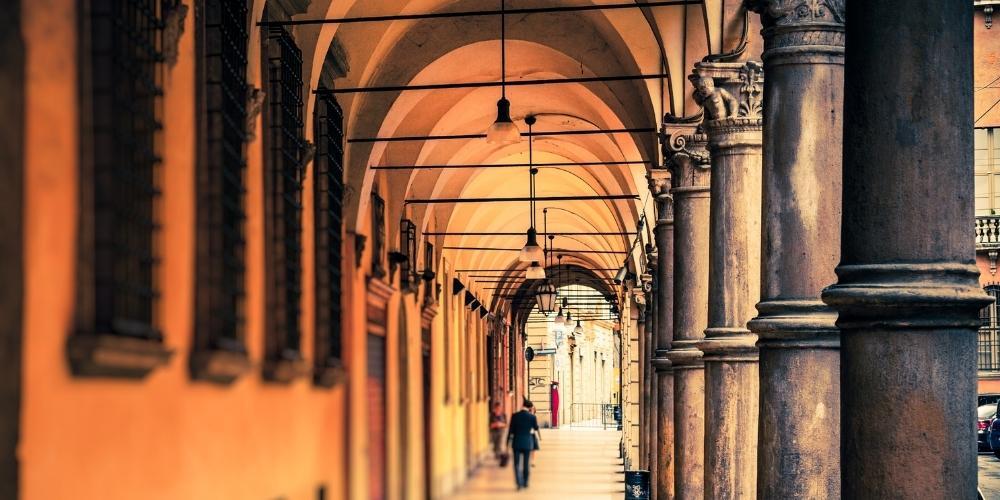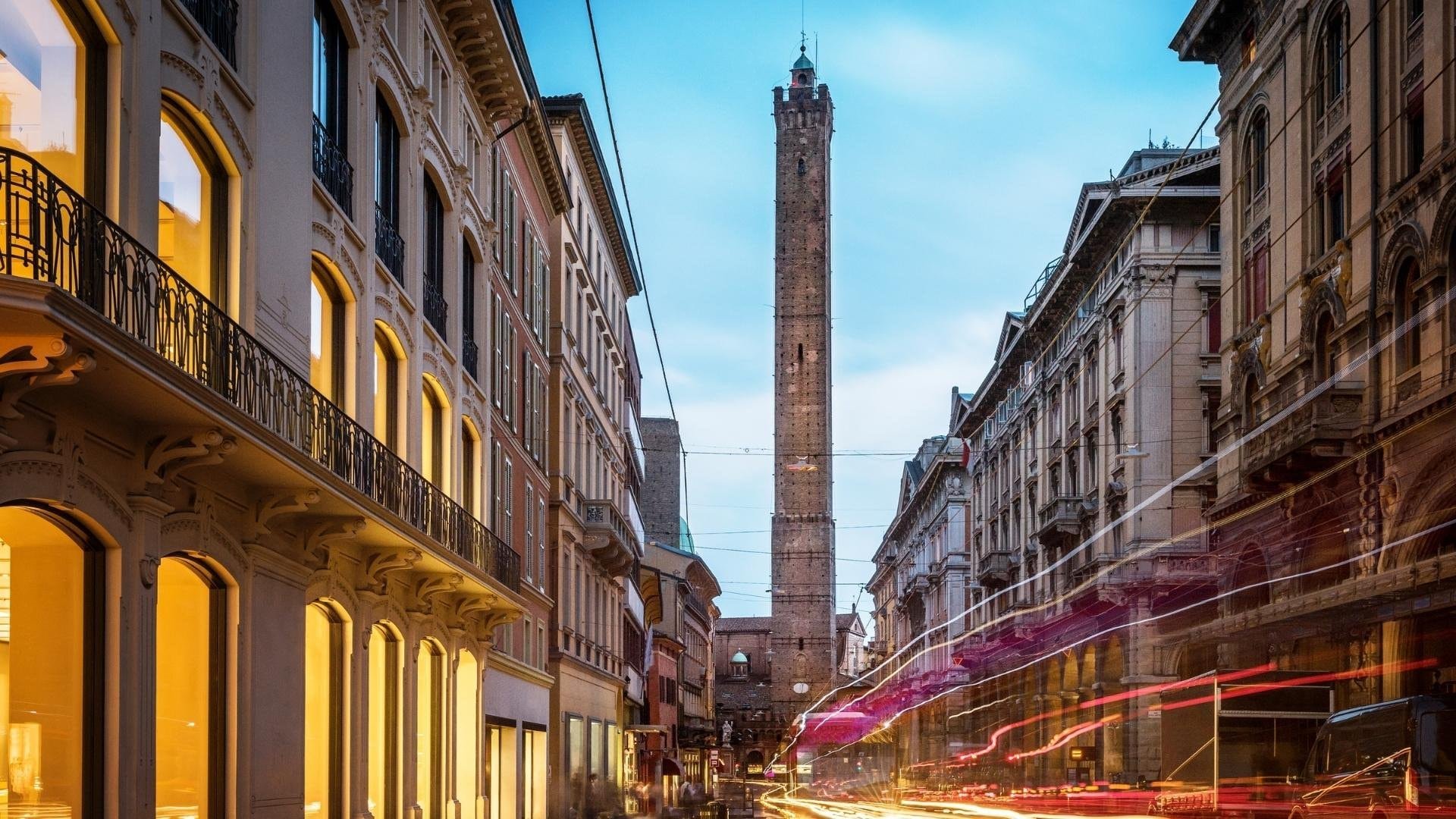Bologna, a city overflowing with life, art, history and flavours. The capital of Italy's region, which is home to tortellini, motors, entertainment and essential architectural treasures, deserves to be discovered in all it has to offer.
If you want to know more about Bologna and what to do and see with some juicy insider tips, we suggest our local guide to the city. Meanwhile, here you'll find everything you need to know about its UNESCO World Heritage site.

Bologna UNESCO World Heritage Site: two awards for the city

UNESCO has crowned Bologna twice. The first time, as a Creative City of Music, in 2006. Then, it was the turn of its porticoes, a World Heritage site since 2021.
Free, independent and unconventional, Bologna is young, if not for the age (it dates back to the 11th contrary BC), in the spirit and ideas of those who live there.
The porticoes of Bologna, a UNESCO World Heritage Site since 2021

Bologna and its icons: the two leaning towers, la Torre degli Asinelli and la Garisenda; a rich gastronomic culture; the oldest university in Europe; its green, rolling hills; music (we will discuss the relationship with the second art shortly below).
What else? Obviously, its storied porticoes, the most classic and recognisable of Bologna's panoramas. Built of wood, concrete, brick or stone, they cover 62 kilometres of streets, squares and walkways.
UNESCO has selected twelve groups of sheltered passageways, both central and peripheral, which together contribute to expressing 'the urban identity of Bologna'. Indeed, it's nearly impossible to imagine the capital of Emilia Romagna without its emblematic architecture.
The porticoed buildings included in the World Heritage property draw an ideal path through time and history and cloak a vibrant historic centre with charm.
They are not a single global gallery but rather a scattered yet ideally continuous ensemble of private networks historically used for public purposes.
Each one, with its own functions and peculiarities, has for centuries punctuated the social life of the Bolognesi, who have the privilege of enjoying it (almost) always dry!
What makes Bologna one of Italy's most famous porticoed cities is the uniqueness of its characteristic covered spaces, mirroring a style of social life that is always active, regardless of the climate and seasons.
This urban planning element, widespread almost everywhere in the world, is particularly 'complete' in terms of type, function and time frame. Some of the oldest arcades still retain their ancient wooden structure—a true rarity.
More than a simple architectural model, the Bolognese porticoes represent a lively and sparkling sociality. Furthermore, they're a place for meeting and exchange, chatting and business that invades everything, from religious to civic or private environments.
The history of Bologna's porticoes

What is the history of Bologna's porticoes? It all began in the Middle Ages. At the time, more and more people poured into the city, amid those who gravitated around the prestigious University and those who left the countryside. The increase in population made it necessary to build new housing units.
So, what did the ingenious Bolognesi do to accommodate the growing number of new inhabitants? They enlarged the upper floors of the buildings by projecting them outwards. The resulting structures were supported by a series of wooden beams resting along the streets. Unexpected 'hybrid' spaces, partly private and partly public corridors, came into being.
The practice, dictated by necessity, became such a routine that in the 13th century, the Municipality of Bologna established the obligation to assemble a portico for every dwelling, not only for both new and old buildings.
According to the time's directives, the porticoes' height and width had to be adequate to allow easy passage for people on horseback.
As for the materials, while at first wood was the most commonly used, brick and stone became increasingly popular from the 16th century onwards .
Bologna's most beautiful UNESCO porticoes

If you have read this far, dear reader, one thing should be clear: it's not a big deal if you forget your umbrella on a rainy day in Bologna.
Anyway, which are the most beautiful porticoes, those under whose arches you can stroll in spite of the weather, wrapped in an irresistibly fresh and lively Bolognese atmosphere?
Let's start with the record-breaking one, the longest in the world. With 3,796 metres in length, 664 arches and 15 chapels, the portico of San Luca is a challenge for those who habitually run up its steps to the Sanctuary of the Madonna di San Luca, 270 metres above sea level.
Let's abandon majesty for decidedly smaller dimensions: in Via Senzanome, you can see the narrowest portico in town, only 95 centimetres wide. In contrast, you'll find the widest flanking the Santa Maria dei Servi basilica, in Strada Maggiore. The tallest one? Outside the Palazzo dell'Arcidiocesi, about 10 metres of high, sober theatricality.
Of all the porticoes in Bologna, the old wooden arcades are probably the most charming. There are eight in the centre. Pay particular attention to the one in Corte Isolani, in Strada Maggiore. If you encounter groups of people with their noses turned up, don't be surprised: they are all looking for three mysterious arrows stuck in the ceiling. Can you see where they are?
Move on to Via Farini, still looking upwards, but this time to admire the beautifully frescoed vaults of the Banca d'Italia building.
Next, you'll find nearby what is considered Bologna's portico par excellence, the Pavaglione, a long succession of arches, vaults and columns that cross palaces and buildings steeped in the city's history. Such as the Archiginnasio complex, home of the ancient university.
Bologna, a UNESCO Creative City of Music since 2006
Since 2006, Bologna has been a Creative City of Music, a UNESCO recognition that celebrates and pays homage to its long and prestigious musical legacy.
Music is indeed one of the pillars of Bologna's identity, the red thread that runs through its history and unites different eras and traditions in a constant and ever-changing cultural ferment.
Predictably, an aspect so profoundly rooted in the local fabric reflects the many institutions housed: the opera house 'Teatro Comunale', the International Music Library and Museum, the Giovanni Battista Martini Conservatory, the Philharmonic Academy.
Likewise, all the international initiatives, festivals and concerts also embrace a wide variety of genres, from classical music to more contemporary sounds, and make Bologna a truly first-class music centre.
To understand how music is intertwined with the history of Bologna, take a 'melodious' itinerary along the footsteps left by musicians and composers (from Mozart to Toscanini, from Rossini to Verdi) over the centuries.
By doing so, you'll touch stops of great appeal and discover one of the most characteristic faces of Bologna. We'll give you some suggestions for your tour right away.
First of all, the Oratory of San Colombano. This ancient 7th-century monastery complex, now deconsecrated, houses a large collection of precious musical instruments, the Tagliavini Collection.
The room of the Stabat Mater is another location worth visiting. On 18 March 1842, Gaetano Donizetti conducted Gioachino Rossini's famous composition there for the first time. The richly decorated hall is located inside the Archiginnasio.
Lastly, we recommend a visit to the basilica of San Petronio. Bologna's largest church houses the two oldest organs in Italy, dating back to the 15th and 16th centuries.
About the author
Written on 02/01/2023



Lorena Calise
Discover Bologna and its UNESCO World Heritage site in a fascinating virtual journey.